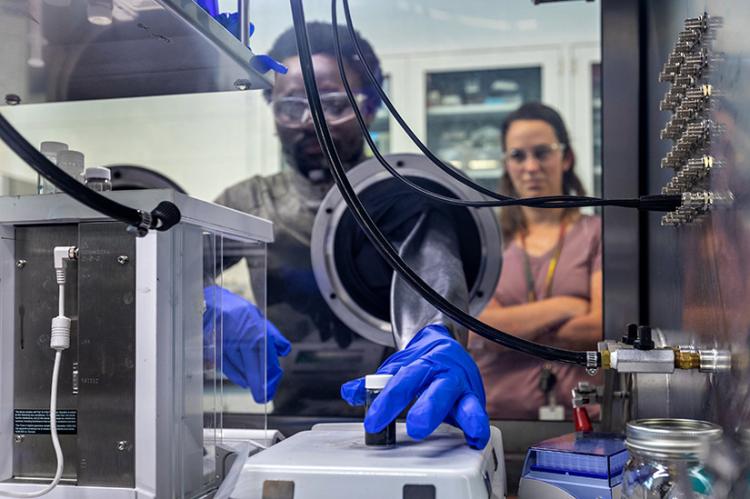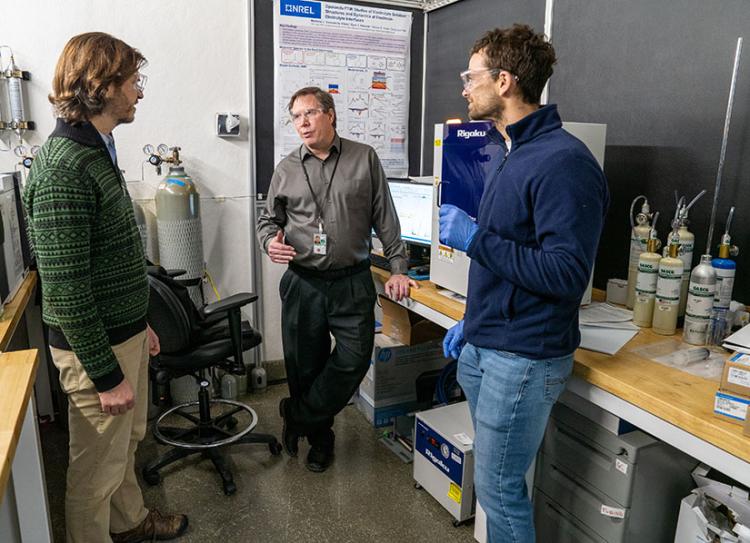
Chemistry scientists Cyrus Kirwa and Jaclyn Cole conduct research into redox relithiation, a form of battery recycling and one of numerous battery research initiatives at NREL. Photo by Werner Slocum, NREL
In the 200 years after its invention, the extraordinary battery has undergone significant evolutions to meet modern applications. These self-contained energy sources are key to our increasingly connected society, powering our communication and transportation networks.
With the shift to renewable energy, a new era of electrification is on the horizon, supported in large part by the breakthrough battery designs that researchers at the National Renewable Energy Laboratory (NREL) believe are at our fingertips.
"NREL's battery research team brings together a diverse range of experts physicists, chemists, and engineers to meet complex challenges in energy storage," said NREL Senior Energy Storage Engineer Matt Keyser. "Our research spans the scale of technology readiness and battery research, from atom-scale materials science to full-scale systems."

From left, Kandler Smith, Matt Keyser, and Andrew Colclasure lead the electrochemical energy storage research at NREL, providing a holistic approach to modeling and diagnostics, materials development, and battery safety. Photo by Werner Slocum, NREL
Today's predominant choice for advances in energy storage, lithium-ion (Li-ion) batteries gained popularity as a lighter and more powerful alternative to lead-acid or nickel-metal hydride designs. These batteries allow users to control energy flow for repeated, high-speed charging and discharging powering everything from cell phones to laptops, electric vehicles (EVs), and large-scale stationary storage. Ongoing research at NREL continues to refine Li-ion batteries to meet the unique needs of different applications.
What does the future of battery storage hold? In the transition to a more electrified society, batteries will play an essential role in helping store energy from renewable sources to supply electricity for buildings, transportation, and grid applications. Emerging battery technologies must focus on reducing costs, while maintaining lifetime and density performance. Using ultramodern capabilities and world-class laboratory facilities, NREL's energy storage researchers continue to push battery boundaries with materials development, thermal management, diagnostics, and modeling.
Materials Research for Lithium-Ion and Beyond
The first level of innovation happens in battery materials synthesis the stage at which developing or refining materials for new battery designs occurs. At a high level, all batteries have a positive electrode (cathode) and a negative electrode (anode) suspended separately within an electrolyte. As electrons move from the anode to the cathode, they generate an electric current and supply electricity. Breakthroughs in material upgrades throughout the battery architecture can unlock better battery performance, stability, and sustainability improvements. However, introducing new materials, such as silicon and sulfur, can also bring about new chemical reactions and mechanical stressors. NREL researchers rise to the challenge of addressing these evolving reactions through careful evaluation of advanced materials, weighing opportunities to meet a variety of applications and needs.
Media may contact:
David Glickson
303-275-4097
david.glickson@nrel.gov









